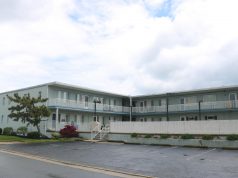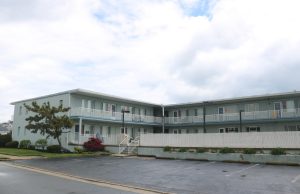The $800,000 consultants charged with devising a plan to bring deeper water back to Ocean City’s clogged lagoons and bay waters met the public on Tuesday and delivered some sobering statistics.
By the last complete estimate, 542,000 cubic yards of bay mud would have to be removed to get the job done from “tip to tip” on the bay side of Ocean City. The current capacity of approved sites to store dredged material: just 8,600 cubic yards.
Representatives of ACT Engineering made a presentation to about 50 people who attended a town hall meeting on dredging plans held at the Ocean City Community Center. The firm was awarded a contract of up to $787,500 to come up with a master plan to dredge all of Ocean City’s shallow bay side — where the water is not navigable for much of the tide cycle.
The task at hand is probably even more monumental, Project Manager Eric Rosina said.
The 542,000 cubic yard estimate is from the most recent five-year state Department of Environmental Protection permit and is from before Superstorm Sandy. But recent field surveys of Snug Harbor (between Eighth and Ninth streets), for instance, show as much as 50 percent more material has accumulated since then, Rosina said.
Ocean City has permits to store 8,600 cubic yards at a new site under the Ninth Street Bridge along the Route 52 causeway.
A disposal site in the marshes near Roosevelt Boulevard (34th Street) is filled to capacity, and Ocean City is spending $2.7 million for a company to free up just 50,000 cubic yards of space by hauling material by barge and truck to a landfill in Wildwood.
Tuesday’s presentation addressed the firm’s short-term plan for 2015 and the broad strategy for a long-term plan that could potentially get the job done in the next five years.
SHORT TERM: SNUG HARBOR
A “limited program for 2015” will be focused on Snug Harbor, according to Rosina.
The lagoon can be seen from the Ninth Street Bridge and is bone dry at low tide.
A $937,900 contract with Wickberg Marine Contracting of Belford, N.J. (the same company emptying “Site 83” off Roosevelt Boulevard) is on the agenda for the City Council meeting scheduled for Thursday (Aug. 27). If approved, work could begin about Sept. 9, according to Carol Beske, the project principal for ACT Engineering.
At about the same time, crews will begin bathymetric surveys to gauge the depth of Ocean City’s entire bay side to get new data on the scope of the problem.
An estimated 14,000 cubic yards of material would have to be removed to make Snug Harbor six feet deeper from the Bay Avenue bulkhead to a 150-square-foot box outside the mouth of the lagoon (leading to the channel). The project area would be from pier to pier and not include private slips.
The material will be removed mechanically (not pumped with water through a pipeline) and transported by barge across the channel to the nearby disposal site.
Because the site has only 8,600 cubic yards of capacity, the contractor will haul material away by truck to the Wildwood landfill to make room to complete the project.
The contractor will be required to dig twice to remove material that fills in immediately.
In response to questions from the public, the consultant said private Snug Harbor slip owners would be permitted by the state to (at their own expense) “piggyback” on the project to dredge their own property. But details of how that might work have not been determined. In any scenario, it would be costly (an estimated $69 per cubic yard for the Snug Harbor work, according to ACT).
LONG TERM: NEW WETLANDS?
The consultants plan to seek permission to build a 1,300-foot road (about 20 to 30 feet wide) to allow truck access from Roosevelt Boulevard to “Site 83,” the location in the marshes currently being emptied by barge.
The road would allow more efficient (but still costly) removal of material from the filled-to-capacity site to facilitate new dredging projects.
But dredging engineer Ram Mohan said unequivocally that the best hope for a sustainable dredging program lies in a wetlands restoration program.
The city received a $2.6 million grant from the U.S. Department of the Interior to experiment with a new technique to “create and stabilize wetlands” — essentially to spread a thin layer of dredged material over a wide area of the marshes.
Mohan said that not only are sea levels rising but that marshes are sinking, or “subsiding.” He said that spraying a thin layer of material (6 to 12 inches) like rain across the marshes would increase the island’s ability to withstand storms and improve wildlife habitat at the same time.
Part of the firm’s work will be to look at historic maps and images of the marshes to determine what can be restored.
He said that while vegetation may temporarily be smothered, it will be full restored and stable within a growing season or two, as long as the new layer stays within a foot.
“It gives us a sustainable and beneficial use of this material,” Mohan said.
He said the same areas could potentially be enhanced twice over time — as long as the marshes remain at a height that keeps them subject to the tides.
Mohan said he would like to get permission to use the grant money to run a pilot program, then build a trust with the state DEP so that future projects would be approved.
Environmental consultant Junetta Dix said the city did go through the exercise of searching for a new disposal site, but no suitable “upland” site of 15 acres or more in reasonable proximity to the project areas could be identified. The state is extremely unlikely to approve any new site that involves wetlands or open water fill, she said.
“I want to go tip to tip, and it’s going to cost a lot of money,” Mayor Jay Gillian said.
He said the city will seek help through outside grants from the state or federal governments.





